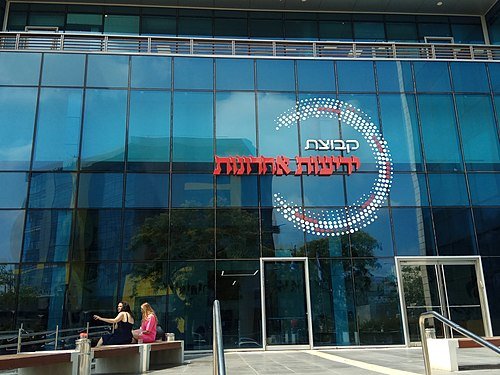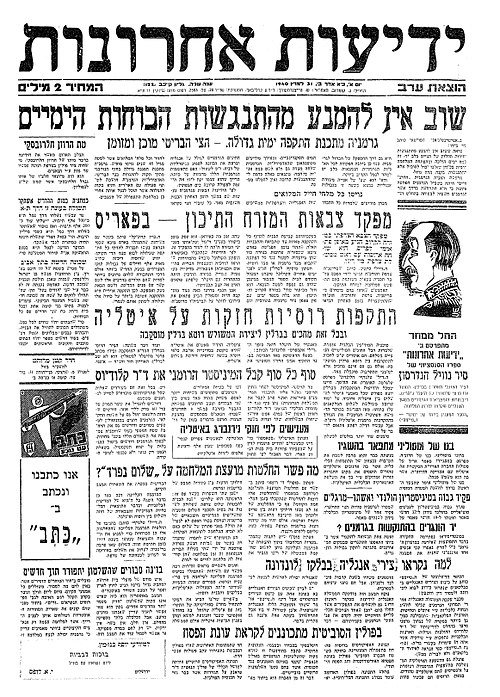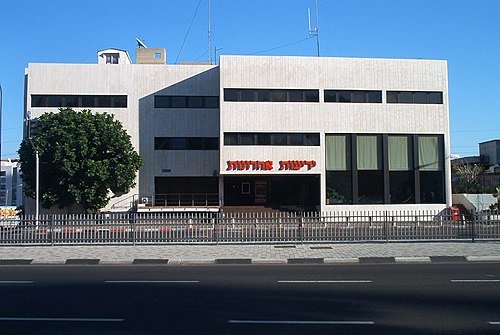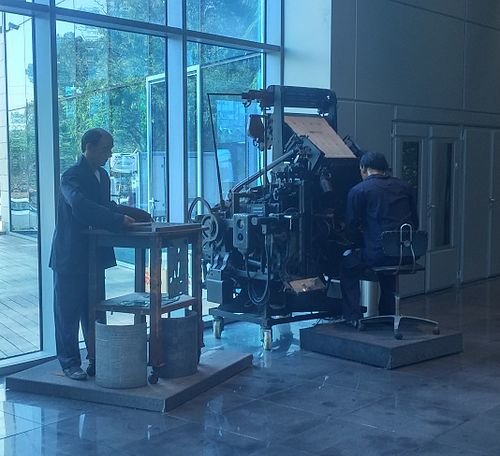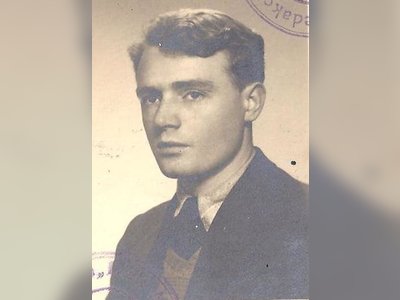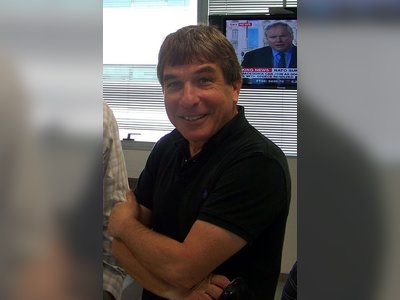"Yedioth Ahronoth: The Story of Israel's Iconic Newspaper"
Yedioth Ahronoth, often referred to simply as "Ynet," is a prominent Israeli newspaper that has been in circulation since December 11, 1939. Since the 1970s, it has been the most widely read newspaper in Israel and, until July 2010, it held the top spot among all Israeli newspapers, eventually conceding the lead to "Israel Hayom."
The newspaper features a tabloid format, with numerous color images and bold headlines, reflecting the style of popular journalism seen worldwide. To attract a large readership, Yedioth Ahronoth is characterized by its light and concise writing style in spoken Hebrew and covers a wide range of topics, from politics and economics to entertainment and gossip.
Yedioth Ahronoth was one of the first privately-owned newspapers in Israel. It was founded in 1939 by Gershom Komarov and was shortly thereafter acquired by Yehuda Mozes. The chief editor responsible was Nahum Mozes, the son of Yehuda Mozes, and the main editor was Ezriel Carlebach.
Survival Struggles
On February 15, 1948, a significant group of journalists, led by editor Ezriel Carlebach, left the newspaper to establish a new publication called "Yedioth Maariv" (later known simply as "Maariv"). This marked the beginning of a fierce competition for readership and prestige among newspapers in Israel.
In the wake of the emergence of this rival publication, Yedioth Ahronoth faced difficulties and fought for its survival. "Maariv" quickly gained an average circulation of 25,000 copies, with peaks of up to 33,000 copies during certain periods. Meanwhile, Yedioth Ahronoth's circulation declined.
To stay in the public's consciousness and maintain its market presence, Yehuda Mozes paid children to run through the streets, loudly proclaiming "Yedioth Ahronoth." Moses did not hesitate to sell properties to cover the newspaper's growing losses. Nahum Mozes took on the task of reviving and rebuilding the newspaper from scratch, even publishing an issue on the very day when the "Maariv" team left.
Initially, prospects for saving the newspaper appeared bleak. "Maariv," under Carlebach's editorship, attracted top senior journalists from Israel, many of whom were known to the readers since their days at Yedioth Ahronoth and earlier in morning newspapers, primarily affiliated with the Revisionist right-wing movement.
"Maariv" appealed to the European-born, Ashkenazi, educated population that predominantly resided in major cities and had been readers of Yedioth Ahronoth and earlier morning newspapers. There was little chance of finding a group of writers who could compete with "Maariv."
The owners of the newspaper, members of the Mozes family, enlisted the help of Dr. Herzl Rosenblum, who was appointed as the chief editor. Rosenblum served as the chief editor of Yedioth Ahronoth for 38 years and wrote the newspaper's main articles every day. The actual editor, who held the title "System Center," was Dov Yudkovsky, a distant relative of Yehuda Mozes and a Holocaust survivor who had been a student at the Hebrew University.
He was called upon to assist in the newspaper's recovery and played a pivotal role in shaping its identity as the "newspaper of the state." This endeavor earned him the Israel Prize for journalism.
A Newspaper of Correspondence
The strategy devised by Nahum Mozes and Yudkovsky aimed to establish Yedioth Ahronoth as a long-term player in the media landscape, targeting the younger generation and new immigrants who were still unfamiliar with Hebrew at the time.
In contrast to the chosen writers of "Maariv," Yudkovsky put together a team of young editors and correspondents for whom Hebrew was their spoken language, and whose understanding of the rapidly changing Israeli reality was closer to the people.
Their task was to create a clear and simple writing style, closer to spoken language. Their role was to shape the entire written newspaper in a unified style, rather than presenting a variety of writing styles from talented journalists, as was seen in "Maariv."
Describing the nature of these correspondents, Nahum Barnea, a senior writer at Yedioth Ahronoth, stated, "Once, before the era of computers, the editor-correspondent sat in front of a typewriter, a cigarette in his mouth, and two of his fingers typed energetically on the machine. Within minutes, he would turn the stack of crumpled pages on his desk into a coherent, coherent, and print-worthy story.
Every veteran journalist has his own list of chosen editors. I think of editors I knew, like Zeev Giladi, for example, or Haim Hanegbi, or Lilia Piter. In my eyes, they were always alchemists: with their fingers, they turned trash into gold."
Yudkovsky was not the first to build a newspaper based on written and unified style. In global journalism, TIME magazine and much of the English-language mass media adopted this approach, including "The Daily Mirror," from which Yudkovsky drew inspiration. In Israel, Uri Avnery and Shalom Cohen, who acquired "HaOlam HaZeh" from Uri Kesari and renamed it, were pioneers of this method.
They were young, daring, and primarily wrote in the Hebrew language of the young generation. The entire newspaper was written (by Cohen and Avnery, and later joined by correspondents Uri Sela, Shmuel More, Max Gilan, Haim Hanegbi, Chaim Hanegbi, Eli Tavor, and others) in this style. The names of these writers rarely appeared in the newspaper.
Yudkovsky's main challenge was to identify people with a natural talent for writing, editing, and sub-editing. He identified such individuals while they were still young and unknown, brought them to the newspaper, and placed them in key positions.
Notable discoveries included Dov Etsmon, a young journalist from Haifa who was appointed as the sports section editor, a pioneering section in the newspapers of that era, and who had a significant influence. Bella Almog was appointed as the editor of the women's supplement "Modern Times."
Ram Oren began his career at Yedioth Ahronoth as a telephone operator and later served as the editor of the daily magazine "24 Hours" for many years. Yoram Vidan served as the deputy editor to Ram Oren, and Zisi Shtwai later became the editor of the literature section. Zeev Giladi, who came from "Haaretz," was appointed as the chief news correspondent and later became the chief editor.
Other editors and writers who worked over the years and contributed to the shaping of the newspaper's language included Uri Sela, poet David Avidan, Moshe Tariaks (later the CEO of Matari Publishing House), Emanuel Bar-Kadma, Sheika Levit, Aharon Weiss, Aharon Bekhor, and more. Among these, Moshe Verdi stood out as he became the newspaper's correspondent in London in the early 1960s and, upon his return, took a leading role in the news desk, later becoming the newspaper's chief editor in 1989.
- ידיעות אחרונותhe.wikipedia.org

